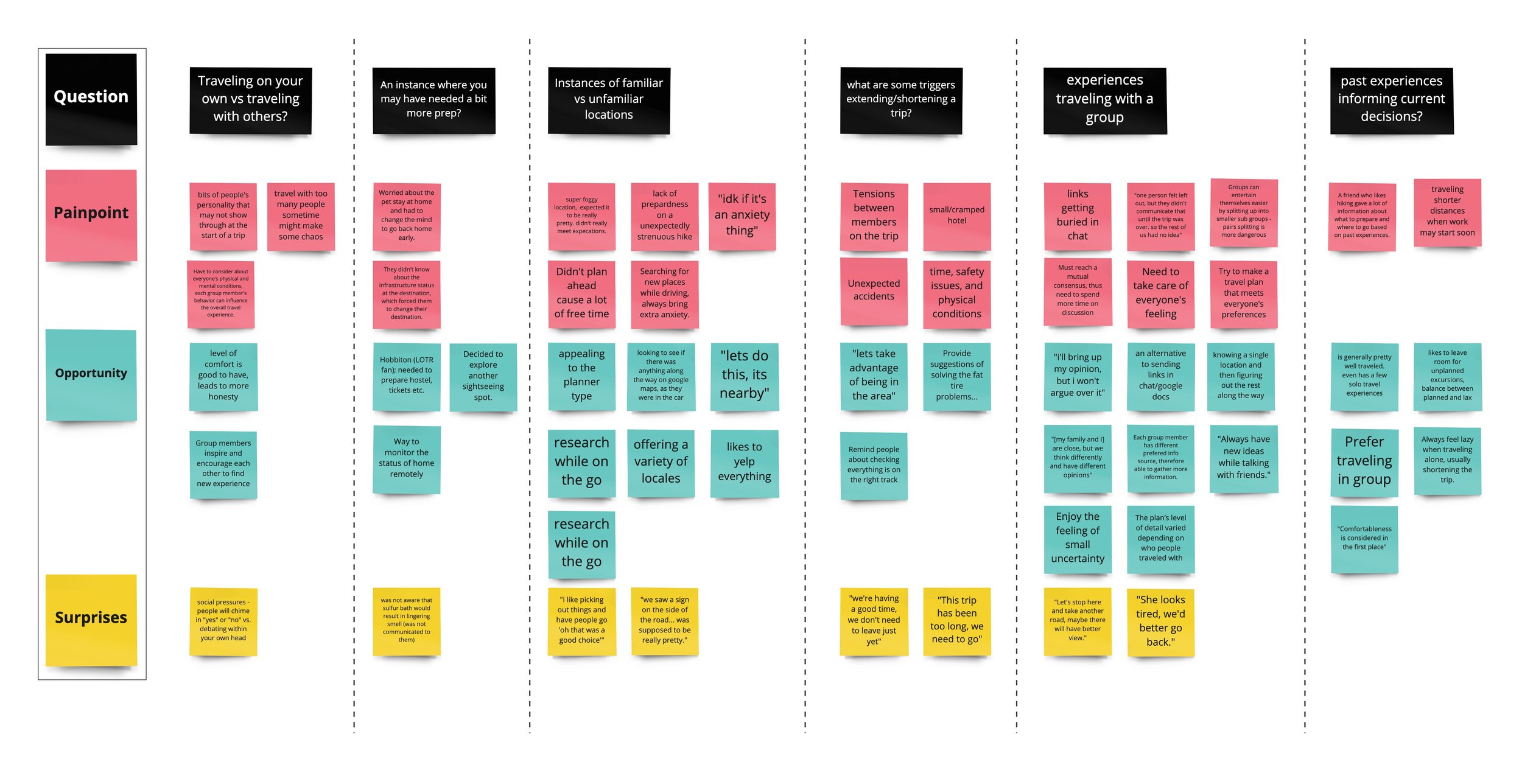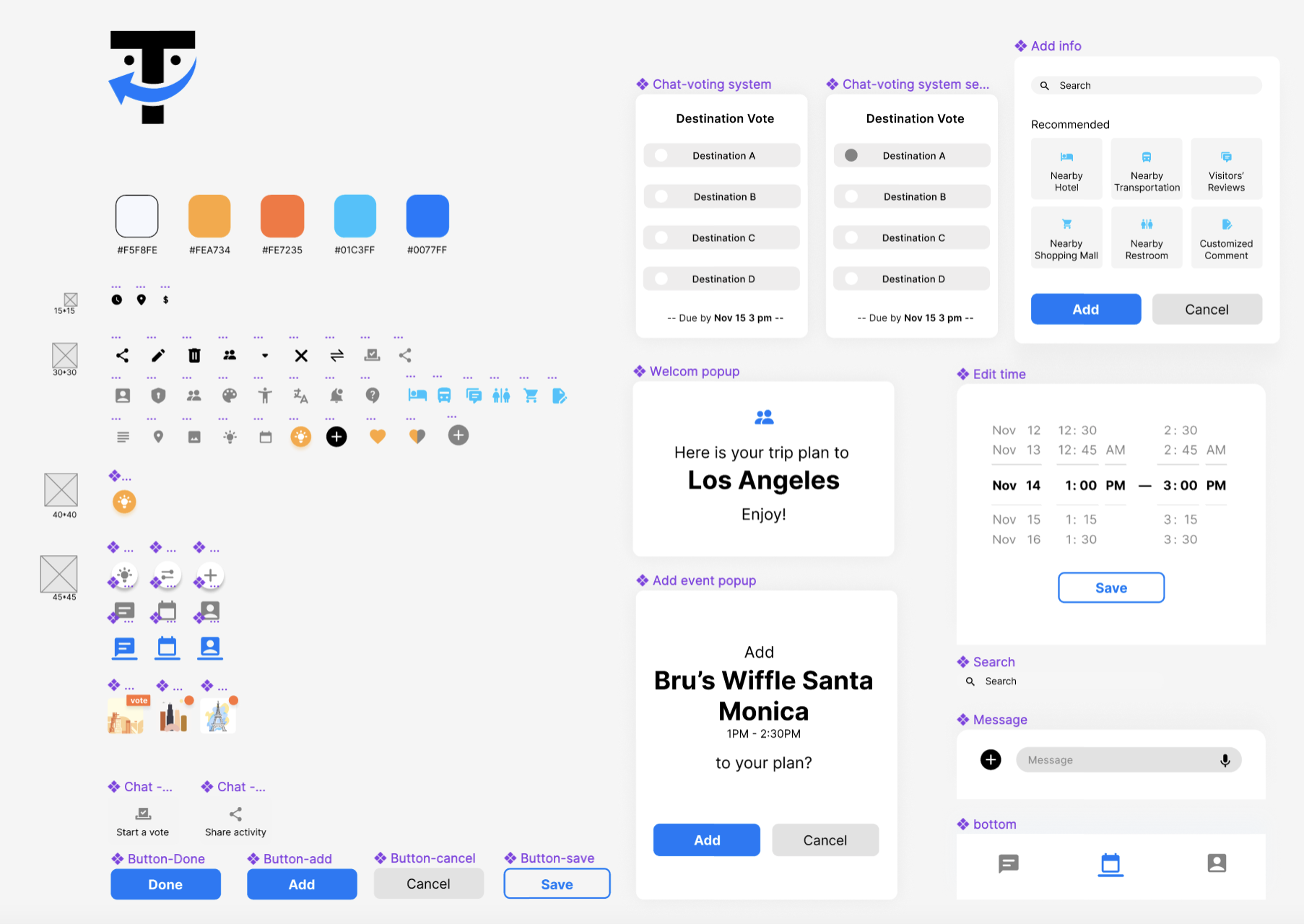
Type
Team Project
Timeline
01/2023 ~ 05/2023
My Role
UI/UX Design
The enjoyment of travel comes from surprise. However, based on our observation, most people strictly follow their original travel plan, which significantly reduces the pleasure.
Better Travel App aims to motivate people to go beyond their comfort zone by providing destination inspiration and detailed information. We aim to reduce the pressure of travel deviation and encourage people to have unexpected happiness.
Our area of research focuses explicitly on the moments when travelers may want to or are required to, deviate from their original plans. There is a level of hesitancy that travelers experience in these moments that stem from both internal motivations as well as external contexts and conditions. So we thought,
Problem
The team started by conducting background research with methods such as Experiential Research, Information Research, and Data Analysis to learn more about problem statements.
Research Goal
What features or social factors influence people with travel planning?
Key Findings
Interesting space for AI-based trip recommendations.
There may be a gap in the market for trip planning for a large group of people and considering everyone's preferences equally.
There are social pressures that affect trip planning.
Background Research
We began our research by conducting Directed Storytelling sessions with 5 users from a variety of backgrounds and learned after synthesizing with Empathy Map and User Journey Maps that travel companions, the balance of spontaneity, external factors such as ‘touristy’ perception, affordability, trust in information source, and proximity to occupation were all major influences on user behavior.
Step 1 User Interview
Step 2 Affinity Diagram
It helped us synthesize the data and generate insights.
Goal
To better understand the conditions and environmental context under which someone might be inclined to want to deviate from their original plans as well as possible factors that may prevent or encourage them from deviating from their original plan.
Method: Directed Storytelling
This contextual method allowed us to glean insights into the interviewee’s thoughts, rationale, and environmental conditions that may have sparked a desire for deviation(s) from their travel plan.
After collecting and sorting out the content of the user interview, we sorted out the important questions we asked. We extracted the possible pain points, opportunities, and surprises through the affinity diagram. This will significantly help us find the solution in the future.
Step 3 User Journey Map
We want to sort out the problems encountered by the interviewees in the user interview in different stages of travel, their current feelings, possible solutions, and opportunities we found.
Key Findings
Other members that the participants travel with can influence their decision-making process.
Enjoyed a balance between well-planned and unplanned excursions.
External factors can deter them from warning them to deviate from their original plan.
They were more likely to deviate from the existing travel plan if the cost was affordable.
They want to choose to travel somewhere which enabled them to be more spontaneous as it would allow them to be able to respond quickly if they were called back.
User Research
To understand the motivation for user travel
Our team generated 18 storyboards that illustrated ways to help travelers deviate from their original travel plan efficiently. We approached our problem from three user needs extracted from user research:
Need to Mediate/reduce interpersonal friction during the decision-making process
Make it easy to voice personal concerns regarding time, safety, and physical conditions.
Engaging in social/public discourse with other members within the travel group leads to people being more willing to be adventurous.
Interview
Insights
Using the storyboards as references, we gathered 5 target audiences who have a group or alone travel experience before and show them the storyboards we created to let them talk about their thoughts.
Goal
Helped us validate their need to address the difficulty in finding spontaneous travel opportunities, as well as the idea to apply social pressure during decision-making and extracting design opportunities.
User Interview
To ideate possible solutions
Our solution is a comprehensive travel planning platform, where users can chat, schedule, budget, and consider spontaneous additions to any preconceived plans. At each stage of our user flow, user preferences are used to provide suggestions that prompt further ideation and inclusion in their trips. Through this process, users can find consensus from all parties on interesting and valuable new travel experiences.
Solution
We tested our Lo-fi prototype with people who most closely resembled our target users - individuals over the age of 18 who had experiences of wanting to, or not wanting to, deviate from their original travel plans. We conducted the usability tests largely over Zoom, over the course of one week, and used an Interview Guide to help direct our conversations.
Goals:
Test whether our prototype
Increases decision-making efficiency when deciding whether or not to deviate from the travel plan.
Increase the number of times users would deviate from their original travel plan.
Has the core set of features that users want in a platform of this use case and is not overwhelming to use.
Key Insights
10 / 10
Thought the platform Increases decision-making efficiency
7 / 10
Increase the number of times users would deviate from their original travel plan.
9 / 10
Has the core set of features
Usability Testing
Design System













